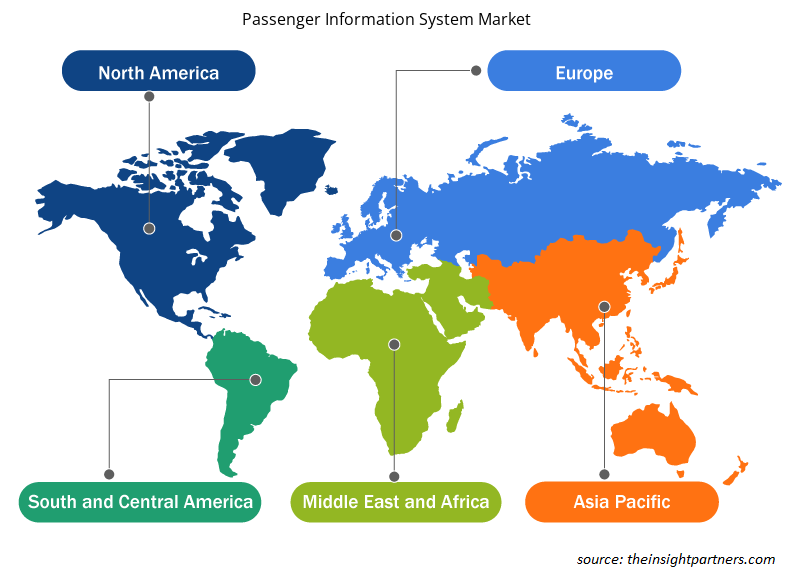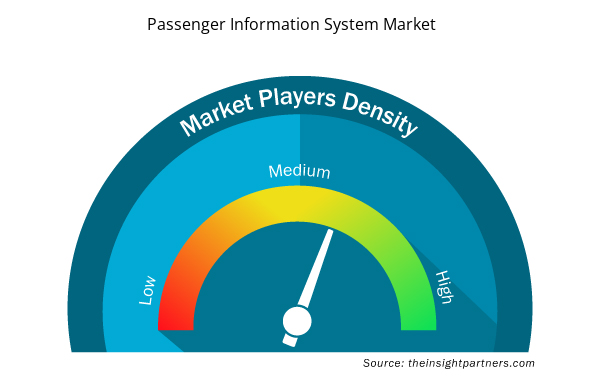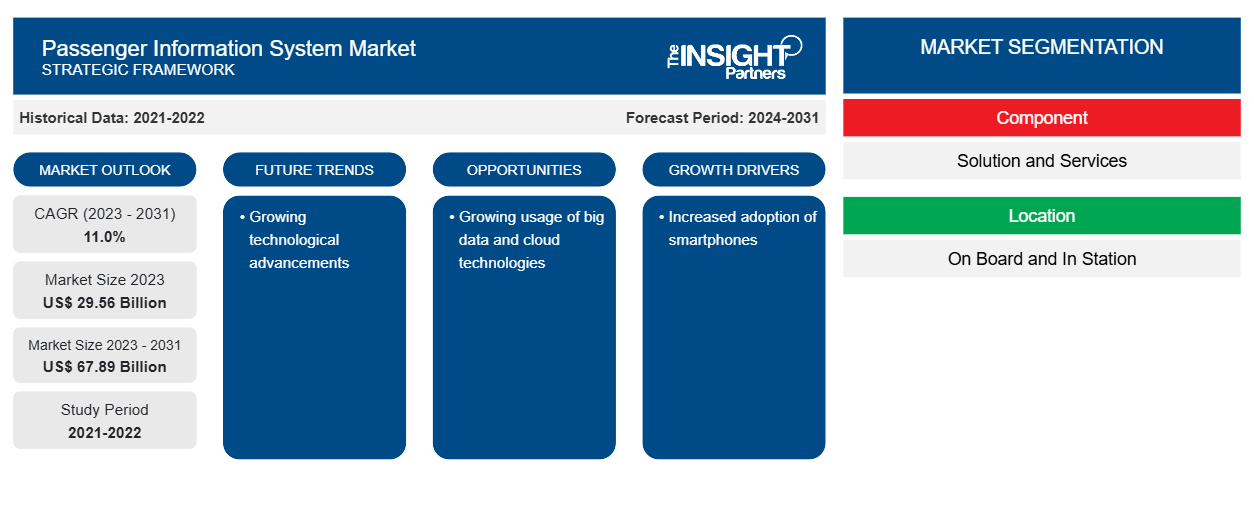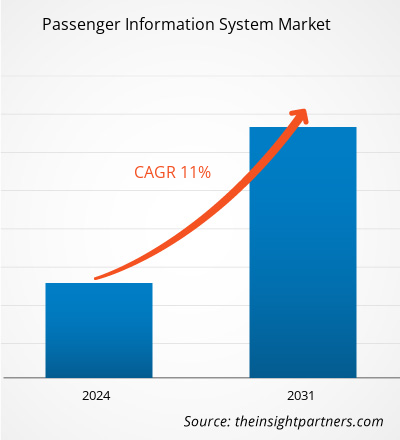Der Markt für Fahrgastinformationssysteme soll von 29,56 Milliarden US-Dollar im Jahr 2023 auf 67,89 Milliarden US-Dollar im Jahr 2031 anwachsen. Der Markt wird voraussichtlich zwischen 2023 und 2031 eine durchschnittliche jährliche Wachstumsrate (CAGR) von 11,0 % verzeichnen. Wachsende technologische Fortschritte werden wahrscheinlich weiterhin die wichtigsten Trends auf dem Markt für Fahrgastinformationssysteme bleiben.
Marktanalyse für Passagierinformationssysteme
Die Nachfrage nach Fahrgastinformationssystemen ist aufgrund mehrerer Faktoren gestiegen, darunter eine Zunahme des Flugverkehrs, eine zunehmende Einführung intelligenter Transportsysteme, eine zunehmende Verbreitung von IoT-Lösungen im Transportsektor und eine steigende Nachfrage der Passagiere nach Echtzeit-Transitinformationen. Darüber hinaus wird erwartet, dass der Markt für Fahrgastinformationssysteme von der steigenden Nachfrage nach allen reisebezogenen Informationen profitiert, von Reiseplanern bis hin zu Änderungen der voraussichtlichen Abfahrtszeiten. Darüber hinaus wird erwartet, dass das gestiegene Bewusstsein der Verkehrsbetriebe, ihren Kunden ein verbessertes Reiseerlebnis zu bieten, die Marktexpansion vorantreiben wird.
Marktübersicht für Passagierinformationssysteme
Der Zweck eines Fahrgastinformationssystems besteht darin, Fahrgästen über Audio- , Video- und Mediengeräte aktuelle Informationen über den Zustand und die Art der Transportdienste zu geben. Es besteht aus einer Sammlung von Hardware- und IT-Komponenten. Es bietet auch Nachrichten- und Unterhaltungsdienste sowie Angaben zu den voraussichtlichen Ankunfts- und Abfahrtszeiten, die alle zu einem verbesserten Reiseerlebnis beitragen. Der Markt für Fahrgastinformationssysteme wächst aufgrund des wachsenden Bedarfs der Verkehrsbetriebe, Fahrgäste mit genauen und zuverlässigen Echtzeit-Transitinformationen zu versorgen. Darüber hinaus wächst der Markt aufgrund von Entwicklungen in der Telekommunikationsbranche, die schnellere Datenübertragungsmöglichkeiten ermöglichen, einem Anstieg der Einführung von IoT im Transportsektor und einer steigenden Nachfrage nach intelligenten Transportsystemen.
Passen Sie diesen Bericht Ihren Anforderungen an
Sie erhalten kostenlos individuelle Anpassungen an jedem Bericht, einschließlich Teilen dieses Berichts oder einer Analyse auf Länderebene, eines Excel-Datenpakets sowie tolle Angebote und Rabatte für Start-ups und Universitäten.
- Holen Sie sich die wichtigsten Markttrends aus diesem Bericht.Dieses KOSTENLOSE Beispiel umfasst eine Datenanalyse von Markttrends bis hin zu Schätzungen und Prognosen.
Markttreiber und Chancen für Passagierinformationssysteme
Zunehmende Nutzung von Smartphones
Da die Smartphone-Nutzung zunimmt, erfreuen sich Fahrgastinformationssysteme auf Basis mobiler Anwendungen zunehmender Beliebtheit. Darüber hinaus konzentrieren sich Verkehrsbetriebe auf mobile Anwendungen für Fahrgastinformationssysteme, um Kunden anzulocken und ihnen über Smartphone-Kanäle Zugang zu schnellen, genauen Informationen in Echtzeit zu verschaffen. Auch der Aufstieg multimodaler Transitanwendungen für den öffentlichen Nahverkehr bietet eine Chance zur Markterweiterung.
Zunehmende Nutzung von Big Data und Cloud-Technologien
Insbesondere Eisenbahnen nutzen Cloud Computing, um viele Transportmittel zu automatisieren. Mithilfe von Cloud Computing-Technologie verfolgt das Fahrgastinformationssystem den Aufenthaltsort von Bussen in der Nähe. Es ermittelt die Ankunftszeit, die dann im Echtzeit-Informationssystem an der Bushaltestelle angezeigt wird. Die Nutzung von Cloud-Technologie und Datenanalyselösungen trägt zu einer effizienten Ressourcenzuweisung und einer wirtschaftlichen Überwachung der Fahrgastzahlen bei.
Segmentierungsanalyse des Marktberichts für Passagierinformationssysteme
Wichtige Segmente, die zur Ableitung der Marktanalyse für Fahrgastinformationssysteme beigetragen haben, sind Komponente, Standort, Transportart und Funktionsmodell.
- Basierend auf den Komponenten ist der Markt für Fahrgastinformationssysteme in Lösungen und Dienste unterteilt. Das Lösungssegment hatte im Jahr 2023 einen größeren Marktanteil.
- Nach Standort ist der Markt in On-Board und In-Station segmentiert. Das On-Board-Segment hielt im Jahr 2023 den größten Marktanteil.
- In Bezug auf die Transportmittel ist der Markt in Straßen, Eisenbahnen, Wasserstraßen und Luftwege unterteilt. Das Straßensegment dominierte den Markt im Jahr 2023.
- Nach Funktionsmodell ist der Markt in Multimedia-Displays, Audiosysteme, Computersysteme, Netzwerk- und Kommunikationsgeräte, Videoüberwachung und Content-Management-Systeme segmentiert.
Marktanteilsanalyse für Passagierinformationssysteme nach Geografie
Der geografische Umfang des Marktberichts zum Fahrgastinformationssystem ist hauptsächlich in fünf Regionen unterteilt: Nordamerika, Asien-Pazifik, Europa, Naher Osten und Afrika sowie Südamerika/Süd- und Mittelamerika. Nordamerika kontrollierte den globalen Markt für Fahrgastinformationssysteme. Darüber hinaus wird der nordamerikanische Markt im Prognosezeitraum wahrscheinlich stark wachsen. Der Hauptfaktor für die Marktexpansion in diesem Bereich ist die Zunahme sowohl der Produktion als auch des Verbrauchs von Fahrgastinformationssystemen in den Industrie- und Entwicklungsländern Nordamerikas. Das PIS gilt als einer der größten Märkte mit einer besonders hohen Nutzung modernster Technologie und einer robusten Netzwerkinfrastruktur. Die Region hat einen erheblichen Einfluss auf die Expansion des Marktes für Fahrgastinformationssysteme aufgrund von Elementen wie der zunehmenden Nutzung des öffentlichen Nahverkehrs und der schnellen Urbanisierung. Darüber hinaus wird erwartet, dass die zunehmende Nutzung von Diensten und Lösungen für Fahrgastinformationssysteme die Expansion fördern wird. All diese Faktoren tragen zum Wachstum des Marktes für Fahrgastinformationssysteme in der Region bei.
Regionale Einblicke in den Markt für Passagierinformationssysteme
Die regionalen Trends und Faktoren, die den Markt für Passagierinformationssysteme im gesamten Prognosezeitraum beeinflussen, wurden von den Analysten von Insight Partners ausführlich erläutert. In diesem Abschnitt werden auch Marktsegmente und Geografie für Passagierinformationssysteme in Nordamerika, Europa, im asiatisch-pazifischen Raum, im Nahen Osten und Afrika sowie in Süd- und Mittelamerika erörtert.

- Erhalten Sie regionale Daten zum Markt für Passagierinformationssysteme
Umfang des Marktberichts zum Passagierinformationssystem
| Berichtsattribut | Details |
|---|---|
| Marktgröße im Jahr 2023 | 29,56 Milliarden US-Dollar |
| Marktgröße bis 2031 | 67,89 Milliarden US-Dollar |
| Globale CAGR (2023 - 2031) | 11,0 % |
| Historische Daten | 2021-2022 |
| Prognosezeitraum | 2024–2031 |
| Abgedeckte Segmente | Nach Komponente
|
| Abgedeckte Regionen und Länder | Nordamerika
|
| Marktführer und wichtige Unternehmensprofile |
|
Marktteilnehmerdichte: Der Einfluss auf die Geschäftsdynamik
Der Markt für Passagierinformationssysteme wächst rasant, angetrieben durch die steigende Nachfrage der Endnutzer aufgrund von Faktoren wie sich entwickelnden Verbraucherpräferenzen, technologischen Fortschritten und einem größeren Bewusstsein für die Vorteile des Produkts. Mit steigender Nachfrage erweitern Unternehmen ihr Angebot, entwickeln Innovationen, um die Bedürfnisse der Verbraucher zu erfüllen, und nutzen neue Trends, was das Marktwachstum weiter ankurbelt.
Die Marktteilnehmerdichte bezieht sich auf die Verteilung der Firmen oder Unternehmen, die in einem bestimmten Markt oder einer bestimmten Branche tätig sind. Sie gibt an, wie viele Wettbewerber (Marktteilnehmer) in einem bestimmten Marktraum im Verhältnis zu seiner Größe oder seinem gesamten Marktwert präsent sind.
Die wichtigsten auf dem Markt für Passagierinformationssysteme tätigen Unternehmen sind:
- TELESTE CORPORATION
- SIEMENS AG
- THALES-GRUPPE
- CUBI CORPORATION
- INDRA SISTEMAS SA
- ALSTOM
Haftungsausschluss : Die oben aufgeführten Unternehmen sind nicht in einer bestimmten Reihenfolge aufgeführt.

- Überblick über die wichtigsten Akteure auf dem Markt für Passagierinformationssysteme
Marktnachrichten und aktuelle Entwicklungen zum Passagierinformationssystem
Der Markt für Fahrgastinformationssysteme wird durch die Erhebung qualitativer und quantitativer Daten nach Primär- und Sekundärforschung bewertet, die wichtige Unternehmensveröffentlichungen, Verbandsdaten und Datenbanken umfasst. Im Folgenden finden Sie eine Liste der Entwicklungen auf dem Markt:
- Im Januar 2021 führte Cubic Corporation zur Erweiterung seines aktuellen Transporttechnologieportfolios die vollständig integrierte Plattformsuite „UMO“ für Mobilität, Fahrgäste, Dienstleister und Verkehrsbehörden ein. UMO ist eine flexible Suite von Tools, mit denen Benutzer Fahrten mit öffentlichen und privaten Verkehrsmitteln planen, bezahlen, Prämien für Fahrten erhalten und aktuelle Informationen zur Steigerung ihrer Mobilität erhalten können.
(Quelle: Cubic Corporation, Unternehmenswebsite)
- Im Juni 2020 wurde das Luftfiltergerät „BlueFiIter“ von der Wabtec Corporation eingeführt, um Fahrgästen in Zügen und U-Bahnen eine saubere, gesunde Umgebung zu bieten. In Waggons beseitigt BlueFilter über 90 % der Schadstoffe.
(Quelle: Wabtec Corporation, Unternehmenswebsite)
Marktbericht zum Passagierinformationssystem – Umfang und Ergebnisse
Der Bericht „Marktgröße und Prognose für Passagierinformationssysteme (2021–2031)“ bietet eine detaillierte Analyse des Marktes, die die folgenden Bereiche abdeckt:
- Marktgröße und Prognose auf globaler, regionaler und Länderebene für alle wichtigen Marktsegmente, die im Rahmen des Projekts abgedeckt sind
- Marktdynamik wie Treiber, Beschränkungen und wichtige Chancen
- Wichtige Zukunftstrends
- Detaillierte PEST/Porters Five Forces- und SWOT-Analyse
- Globale und regionale Marktanalyse mit wichtigen Markttrends, wichtigen Akteuren, Vorschriften und aktuellen Marktentwicklungen
- Branchenlandschaft und Wettbewerbsanalyse, einschließlich Marktkonzentration, Heatmap-Analyse, prominenten Akteuren und aktuellen Entwicklungen
- Detaillierte Firmenprofile
- Historische Analyse (2 Jahre), Basisjahr, Prognose (7 Jahre) mit CAGR
- PEST- und SWOT-Analyse
- Marktgröße Wert/Volumen – Global, Regional, Land
- Branche und Wettbewerbsumfeld
- Excel-Datensatz



Report Coverage
Revenue forecast, Company Analysis, Industry landscape, Growth factors, and Trends

Segment Covered
This text is related
to segments covered.

Regional Scope
North America, Europe, Asia Pacific, Middle East & Africa, South & Central America

Country Scope
This text is related
to country scope.
Häufig gestellte Fragen
The global passenger information system market is expected to grow at a CAGR of 11.0 % during the forecast period 2023 - 2031.
Increased adoption of smartphones and growing usage of big data and cloud technologies are the major factors that propel the global passenger information system market.
Growing technological advancements are anticipated to play a significant role in the global passenger information system market in the coming years.
The key players holding majority shares in the global passenger information system market are Alstom, Cubic Corporation, Hitachi, Ltd., Indra, and Mitsubishi Electric Corporation.
The global passenger information system market is expected to reach US$ 67.89 billion by 2031.
Trends and growth analysis reports related to Technology, Media and Telecommunications : READ MORE..
The Insight Partners performs research in 4 major stages: Data Collection & Secondary Research, Primary Research, Data Analysis and Data Triangulation & Final Review.
- Data Collection and Secondary Research:
As a market research and consulting firm operating from a decade, we have published and advised several client across the globe. First step for any study will start with an assessment of currently available data and insights from existing reports. Further, historical and current market information is collected from Investor Presentations, Annual Reports, SEC Filings, etc., and other information related to company’s performance and market positioning are gathered from Paid Databases (Factiva, Hoovers, and Reuters) and various other publications available in public domain.
Several associations trade associates, technical forums, institutes, societies and organization are accessed to gain technical as well as market related insights through their publications such as research papers, blogs and press releases related to the studies are referred to get cues about the market. Further, white papers, journals, magazines, and other news articles published in last 3 years are scrutinized and analyzed to understand the current market trends.
- Primary Research:
The primarily interview analysis comprise of data obtained from industry participants interview and answers to survey questions gathered by in-house primary team.
For primary research, interviews are conducted with industry experts/CEOs/Marketing Managers/VPs/Subject Matter Experts from both demand and supply side to get a 360-degree view of the market. The primary team conducts several interviews based on the complexity of the markets to understand the various market trends and dynamics which makes research more credible and precise.
A typical research interview fulfils the following functions:
- Provides first-hand information on the market size, market trends, growth trends, competitive landscape, and outlook
- Validates and strengthens in-house secondary research findings
- Develops the analysis team’s expertise and market understanding
Primary research involves email interactions and telephone interviews for each market, category, segment, and sub-segment across geographies. The participants who typically take part in such a process include, but are not limited to:
- Industry participants: VPs, business development managers, market intelligence managers and national sales managers
- Outside experts: Valuation experts, research analysts and key opinion leaders specializing in the electronics and semiconductor industry.
Below is the breakup of our primary respondents by company, designation, and region:

Once we receive the confirmation from primary research sources or primary respondents, we finalize the base year market estimation and forecast the data as per the macroeconomic and microeconomic factors assessed during data collection.
- Data Analysis:
Once data is validated through both secondary as well as primary respondents, we finalize the market estimations by hypothesis formulation and factor analysis at regional and country level.
- Macro-Economic Factor Analysis:
We analyse macroeconomic indicators such the gross domestic product (GDP), increase in the demand for goods and services across industries, technological advancement, regional economic growth, governmental policies, the influence of COVID-19, PEST analysis, and other aspects. This analysis aids in setting benchmarks for various nations/regions and approximating market splits. Additionally, the general trend of the aforementioned components aid in determining the market's development possibilities.
- Country Level Data:
Various factors that are especially aligned to the country are taken into account to determine the market size for a certain area and country, including the presence of vendors, such as headquarters and offices, the country's GDP, demand patterns, and industry growth. To comprehend the market dynamics for the nation, a number of growth variables, inhibitors, application areas, and current market trends are researched. The aforementioned elements aid in determining the country's overall market's growth potential.
- Company Profile:
The “Table of Contents” is formulated by listing and analyzing more than 25 - 30 companies operating in the market ecosystem across geographies. However, we profile only 10 companies as a standard practice in our syndicate reports. These 10 companies comprise leading, emerging, and regional players. Nonetheless, our analysis is not restricted to the 10 listed companies, we also analyze other companies present in the market to develop a holistic view and understand the prevailing trends. The “Company Profiles” section in the report covers key facts, business description, products & services, financial information, SWOT analysis, and key developments. The financial information presented is extracted from the annual reports and official documents of the publicly listed companies. Upon collecting the information for the sections of respective companies, we verify them via various primary sources and then compile the data in respective company profiles. The company level information helps us in deriving the base number as well as in forecasting the market size.
- Developing Base Number:
Aggregation of sales statistics (2020-2022) and macro-economic factor, and other secondary and primary research insights are utilized to arrive at base number and related market shares for 2022. The data gaps are identified in this step and relevant market data is analyzed, collected from paid primary interviews or databases. On finalizing the base year market size, forecasts are developed on the basis of macro-economic, industry and market growth factors and company level analysis.
- Data Triangulation and Final Review:
The market findings and base year market size calculations are validated from supply as well as demand side. Demand side validations are based on macro-economic factor analysis and benchmarks for respective regions and countries. In case of supply side validations, revenues of major companies are estimated (in case not available) based on industry benchmark, approximate number of employees, product portfolio, and primary interviews revenues are gathered. Further revenue from target product/service segment is assessed to avoid overshooting of market statistics. In case of heavy deviations between supply and demand side values, all thes steps are repeated to achieve synchronization.
We follow an iterative model, wherein we share our research findings with Subject Matter Experts (SME’s) and Key Opinion Leaders (KOLs) until consensus view of the market is not formulated – this model negates any drastic deviation in the opinions of experts. Only validated and universally acceptable research findings are quoted in our reports.
We have important check points that we use to validate our research findings – which we call – data triangulation, where we validate the information, we generate from secondary sources with primary interviews and then we re-validate with our internal data bases and Subject matter experts. This comprehensive model enables us to deliver high quality, reliable data in shortest possible time.


 Holen Sie sich ein kostenloses Muster für diesen Bericht
Holen Sie sich ein kostenloses Muster für diesen Bericht